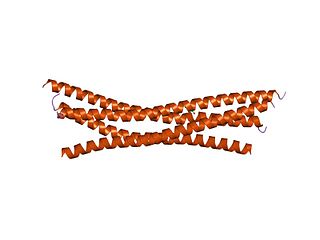
The sodium-hydrogen antiporter 1 (NHE-1) also known as sodium/hydrogen exchanger 1 or SLC9A1 is an isoform of sodium–hydrogen antiporter that in humans is encoded by the SLC9A1 gene.

Sodium-hydrogen antiporter 3 regulator 1 is a regulator of Sodium-hydrogen antiporter 3. It is encoded by the gene SLC9A3R1. It is also known as ERM Binding Protein 50 (EBP50) or Na+/H+ Exchanger Regulatory Factor (NHERF1). It is believed to interact via long-range allostery, involving significant protein dynamics.

Ras-related protein Rab-11A is a protein that in humans is encoded by the RAB11A gene.

The CLCN5 gene encodes the chloride channel Cl-/H+ exchanger ClC-5. ClC-5 is mainly expressed in the kidney, in particular in proximal tubules where it participates to the uptake of albumin and low-molecular-weight proteins, which is one of the principal physiological role of proximal tubular cells. Mutations in the CLCN5 gene cause an X-linked recessive nephropathy named Dent disease characterized by excessive urinary loss of low-molecular-weight proteins and of calcium (hypercalciuria), nephrocalcinosis and nephrolithiasis.

Sodium-hydrogen exchange regulatory cofactor NHE-RF2 (NHERF-2) also known as tyrosine kinase activator protein 1 (TKA-1) or SRY-interacting protein 1 (SIP-1) is a protein that in humans is encoded by the SLC9A3R2 gene.

Sodium–hydrogen antiporter 3 also known as sodium–hydrogen exchanger 3 (NHE3) or solute carrier family 9 member 3 (SLC9A3) is a protein that in humans is encoded by the SLC9A3 gene.

Syntaxin-7 is a protein that in humans is encoded by the STX7 gene.

Syntaxin-6 is a protein that in humans is encoded by the STX6 gene.

Secretory carrier-associated membrane protein 1 is a protein that in humans is encoded by the SCAMP1 gene.

Vesicle-associated membrane protein 3 is a protein that in humans is encoded by the VAMP3 gene.

PIKfyve, a FYVE finger-containing phosphoinositide kinase, is an enzyme that in humans is encoded by the PIKFYVE gene.

Calcineurin B homologous protein 1 is a protein encoded in humans by the CHP1 gene.

Rab11 family-interacting protein 5 is a protein that in humans is encoded by the RAB11FIP5 gene.

Vesicle-associated membrane protein 4 is a protein that in humans is encoded by the VAMP4 gene.

Myosin-Vb, a myosin V type protein, is encoded by the MYO5B gene in humans.

Zinc finger FYVE domain-containing protein 16 is a protein that in humans is encoded by the ZFYVE16 gene.

Sodium/hydrogen exchanger 5 is a protein that in humans is encoded by the SLC9A5 gene.

Syntaxin-1B is a protein that in humans is encoded by the STX1B gene.

StAR related lipid transfer domain containing 3(STARD3) is a protein that in humans is encoded by the STARD3 gene. STARD3 also known as metastatic lymph node 64 protein (MLN64) is a late endosomal integral membrane protein involved in cholesterol transport. STARD3 creates membrane contact sites between the endoplasmic reticulum and late endosomes where it moves cholesterol.
Rajini Rao is an Indian Physiologist and Professor at Johns Hopkins University School of Medicine. Rao is also the Director of the Graduate Program in Cellular and Molecular Medicine and is the principal investigator of the Rao Lab. Rao discovers novel ion channels and explores their roles in human health and disease. The Rao Lab identified the oncogenic role of SPCA2 in breast cancer through an aberrant method of signalling to calcium channels.



















